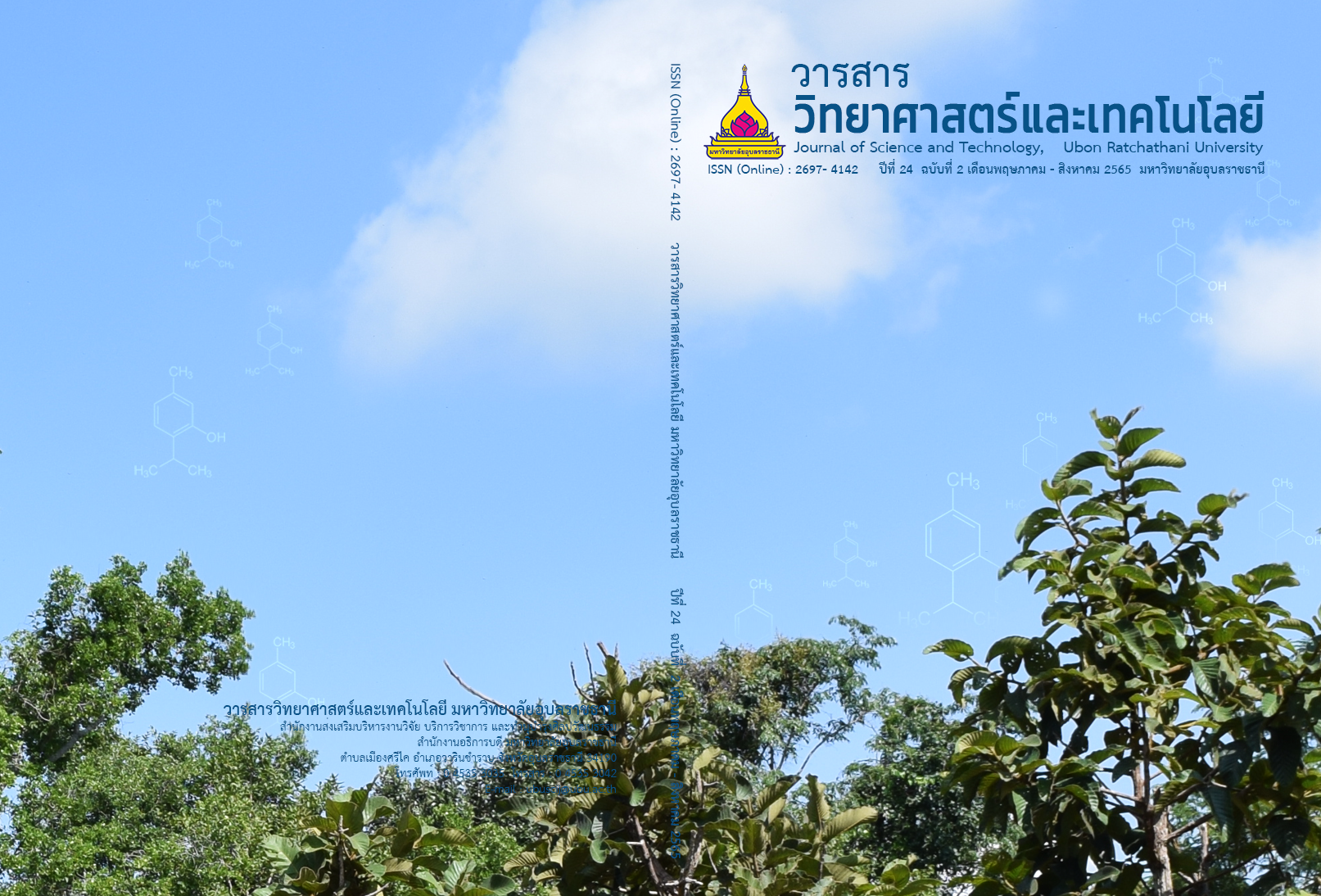ผลของการแปรรูปและการเก็บรักษาต่อการเปลี่ยนแปลงปริมาณสารอาหารและ ความสามารถในการต้านอนุมูลอิสระของผลิตภัณฑ์จากเม่า
Main Article Content
บทคัดย่อ
งานวิจัยนี้มีวัตถุประสงค์เพื่อศึกษาผลของกระบวนการแปรรูปและการเก็บรักษาต่อปริมาณสารอาหารและความสามารถในการต้านอนุมูลอิสระของผลิตภัณฑ์เม่า (Antidesma bunius) โดยในงานวิจัยนี้ใช้ผลิตภัณฑ์จากเม่าทั้งหมด 4 ชนิด ได้แก่ น้ำเม่าแท้ (100%), น้ำเม่าพร้อมดื่ม (30%), น้ำเม่าเข้มข้น และไวน์เม่า น้ำเม่าดำ 100 มิลลิลิตร ให้พลังงาน 80 กิโลแคลอรี มีความชื้น ไขมัน คาร์โบไฮเดรตทั้งหมดรวมใยอาหาร ใยอาหาร โปรตีน เท่ากับ 80.30, 0.00, 20.00, 0.53, และ น้อยกว่า 1.25 กรัม ตามลำดับ เมื่อนำน้ำเม่าดำเข้าสู่กระบวนพาสเจอร์ไรส์เพื่อให้ได้เป็นน้ำเม่าแท้ พบว่าน้ำเม่าแท้ (100%) 100 มิลลิลิตร ให้พลังงาน และปริมาณคาร์โบไฮเดรตเพิ่มขึ้น ส่วนวิตามิน A, B1 และ B2 มีปริมาณลดลงเล็กน้อย ในขณะที่ วิตามิน C ลดลงมาก ส่วนแร่ธาตุต่าง ๆ มีการเปลี่ยนแปลงน้อยมาก นอกจากนี้ยังพบว่ากระบวนการพาสเจอร์ไรส์น้ำเม่าพร้อมดื่ม (30%) และน้ำเม่าเข้มข้นทำให้ปริมาณสารประกอบฟีนอลิคเพิ่มสูงขึ้น แต่ทำให้ความสามารถในการต้านอนุมูลอิสระต่อ DPPH ลดลง ส่วนการเก็บรักษาไวน์เม่าที่อุณหภูมิ 30 องศาเซลเซียส เป็นเวลา 6 เดือน ไม่มีผลต่อปริมาณสารฟีนอลิค และความสามารถในการต้านอนุมูลอิสระ ผลจากงานวิจัยนี้แสดงให้เห็นว่ากระบวนการแปรรูปมีผลต่อปริมาณสารอาหารและความสามารถในการต้านอนุมูลอิสระของผลิตภัณฑ์เม่าทั้งหมด 4 ชนิดระดับที่ยอมรับได้
Article Details

อนุญาตภายใต้เงื่อนไข Creative Commons Attribution-NonCommercial-NoDerivatives 4.0 International License.
บทความที่ได้รับการตีพิมพ์เป็นลิขสิทธิ์ของ วารสารวิทยาศาสตร์และเทคโนโลยี มหาวิทยาลัยอุบลราชธานี
ข้อความที่ปรากฏในบทความแต่ละเรื่องในวารสารวิชาการเล่มนี้เป็นความคิดเห็นส่วนตัวของผู้เขียนแต่ละท่านไม่เกี่ยวข้องกับมหาวิทยาลัยอุบลราชธานี และคณาจารย์ท่านอื่นๆในมหาวิทยาลัยฯ แต่อย่างใด ความรับผิดชอบองค์ประกอบทั้งหมดของบทความแต่ละเรื่องเป็นของผู้เขียนแต่ละท่าน หากมีความผิดพลาดใดๆ ผู้เขียนแต่ละท่านจะรับผิดชอบบทความของตนเองแต่ผู้เดียว
เอกสารอ้างอิง
Kumklang, A. and Sangkaew, W. 2000. The Invention of Products from the Mao. Bangkok: Khurusapha. (in Thai)
Butkhup, L. and Samappito, S. 2008. Analysis of anthocyanin, flavonoids, and phenolic acids in tropical bignay berries. International Journal of Fruit Science. 8(1-2): 15-34.
Hemathulin, S. and Sombun, K. 2015. The functional Mao (Antidesma bunius) jelly drink with mucilage, biological extracts from hairy basil seed. Khon Kaen Agriculture Journal. 43(Suppl. 1): 299-304. (in Thai)
Wilhelmina, K. 2006. Effects of production and processing factors on major fruit and vegetable antioxidants. Journal of Food Science 70(1): R11-R19.
Morarach, A. and Hemathulin, S. 2021. Physical properties, phenolic contents and antioxidant activity of Mao Luang. Journal of Science and Technology, Ubon Ratchathani University. 23(3): 70-79. (in Thai)
Ferreira, V.B. and et al. 2015. Total phenolic compounds and antioxidant activity of organic vegetables consumed in Brazil. Food and Nutrition Sciences. 6(9): 798-804.
Schmidt, M., John, W.J. and Mary, A. 2006. Effects of food processing on blueberry antiproliferation and antioxidant activity. Journal of Food Science. 70(6): 389-394.
Eichhorn, S. and Winterhalter, P. 2005. Antocyanins from pigmentrd potato (Solanum tuberosum L.) varieties. Food Research International. 38: 943-948.
Wichana, W., Songsri P. and Sripui, J. 2017. Evaluation of genetic diversity in Mamao luang (Antidesma thwaitesianum Muell. Arg.). Khon Kaen Agriculture Journal. 45(1): 15-24. (in Thai)
Krongyut, O. and Sutthanut, K. 2019. Phenolic profile, antioxidant activity, and anti-obesogenic bioactivity of Mao Luang fruits (Antidesma bunius L.). Molecules. 24(22): 4109.
Butkhup, L. 2012. Dietary polyphenols and their biological effects. Journal of Science and Technology, Mahasarakham University. 31(4): 443-445. (in Thai)
Promkhan, S., Sappaso, S. and Saythi, S. 2008. Effect of vacuum drying conditions on Mao powder quality. In: Proceedings of the5th Kasetsart University Kamphaeng Saen Campus Conference, 8-9 December 2008. Nakhon Pathom, Thailand. (in Thai)
Jongjitt, K. and et al. 2017. Determination of antioxidant, total phenolic compounds and facial cream formulation from Antidesma bunius extract. Isan Journal of Pharmaceutical Sciences. 13(Suppl.): 209-218.
Potisate, Y. and Wutthinithisanand, N. 2021. Type and sucrose content on antioxidant activity of mulberry jam. King Mongkut’s Agricultural Journal. 39(2) : 165-171.
Cushnie, B. and et al. 2018. Alpha-amylase inhibition and antioxidant activities of ethanolic crude extract of Ficus racemosa Linn. fruit. Thai Science and Technology Journal. 27(5): 951-963. (in Thai)


